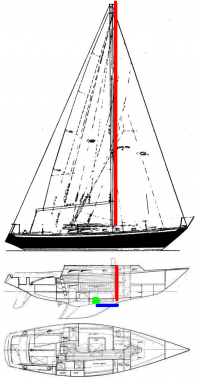knoisewater
Member I
Kind of a weird question. I have a '78 Ericson 35 MKII, and I'm dinking around with making my own instruments. One of the things I have figured out is how to remove induced wind from the anemometer measurement (on a no wind day at anchor, if a wave moves under a boat, the mast will rock back and forth, registering wind... even though there is none. This system calculates and removes what that induced wind is).
The problem is that I need to know the exact center of rotation. As in, the specific point where the boat rolls, pitches, and yaws about. I suppose I could go out and give her a few hard turns in calm water to kind of see the axis is turns around, but being in the SF Bay, that doesn't seem likely.
I've kind of eyeballed it based on total anecdotal "That looks about right" knowledge to be about here (at the green dot):

I do believe this is different from the boat's center of mass, which can be shifted around and whatnot, just like an airplane's center of mass can shift but it's center of lift is based on the wing's shape.
Where do you think it is?
The problem is that I need to know the exact center of rotation. As in, the specific point where the boat rolls, pitches, and yaws about. I suppose I could go out and give her a few hard turns in calm water to kind of see the axis is turns around, but being in the SF Bay, that doesn't seem likely.
I've kind of eyeballed it based on total anecdotal "That looks about right" knowledge to be about here (at the green dot):
I do believe this is different from the boat's center of mass, which can be shifted around and whatnot, just like an airplane's center of mass can shift but it's center of lift is based on the wing's shape.
Where do you think it is?
Attachments
Last edited:

